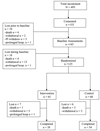A controlled trial of an intervention to improve urinary and fecal incontinence and constipation
- PMID: 20653804
- PMCID: PMC2955182
- DOI: 10.1111/j.1532-5415.2010.02978.x
A controlled trial of an intervention to improve urinary and fecal incontinence and constipation
Abstract
Objectives: To evaluate effects of a multicomponent intervention on fecal incontinence (FI) and urinary incontinence (UI) outcomes.
Design: Randomized controlled trial.
Setting: Six nursing homes (NHs).
Participants: One hundred twelve NH residents.
Intervention: Intervention subjects were offered toileting assistance, exercise, and choice of food and fluid snacks every 2 hours for 8 hours per day over 3 months.
Measurements: Frequency of UI and FI and rate of appropriate toileting as determined by direct checks from research staff. Anorectal assessments were completed on a subset of 29 residents.
Results: The intervention significantly increased physical activity, frequency of toileting, and food and fluid intake. UI improved (P=.049), as did frequency of bowel movements (P<.001) and percentage of bowel movements (P<.001) in the toilet. The frequency of FI did not change. Eighty-nine percent of subjects who underwent anorectal testing showed a dyssynergic voiding pattern, which could explain the lack of efficacy of this intervention program alone on FI.
Conclusion: This multicomponent intervention significantly changed multiple risk factors associated with FI and increased bowel movements without decreasing FI. The dyssynergic voiding pattern and rectal hyposensitivity suggest that future interventions may have to be supplemented with bulking agents (fiber), biofeedback therapy, or both to improve bowel function.
© 2010, Copyright the Authors. Journal compilation © 2010, The American Geriatrics Society.
Conflict of interest statement
Dr. Felix W. Leung: Oceanic therapeutics and produces constipation medication.
Similar articles
-
Effects of prompted voiding on fecal continence among nursing home residents.J Am Geriatr Soc. 1996 Apr;44(4):424-8. doi: 10.1111/j.1532-5415.1996.tb06415.x. J Am Geriatr Soc. 1996. PMID: 8636590 Clinical Trial.
-
Urinary and fecal incontinence in nursing homes.Gastroenterology. 2004 Jan;126(1 Suppl 1):S41-7. doi: 10.1053/j.gastro.2003.10.017. Gastroenterology. 2004. PMID: 14978637 Review.
-
Prevalence of constipation symptoms in fecally incontinent nursing home residents.J Am Geriatr Soc. 2009 Apr;57(4):647-52. doi: 10.1111/j.1532-5415.2009.02215.x. J Am Geriatr Soc. 2009. PMID: 19392956 Free PMC article. Clinical Trial.
-
Prevention of urinary and fecal incontinence in adults.Evid Rep Technol Assess (Full Rep). 2007 Dec;(161):1-379. Evid Rep Technol Assess (Full Rep). 2007. PMID: 18457475 Free PMC article. Review.
-
3D High-definition anorectal manometry: Values obtained in asymptomatic volunteers, fecal incontinence and chronic constipation. Results of a prospective multicenter study (NOMAD).Neurogastroenterol Motil. 2017 Aug;29(8). doi: 10.1111/nmo.13049. Epub 2017 Mar 2. Neurogastroenterol Motil. 2017. PMID: 28251732
Cited by
-
Regenerative potential of human dental pulp stem cells in the treatment of stress urinary incontinence: In vitro and in vivo study.Cell Prolif. 2019 Nov;52(6):e12675. doi: 10.1111/cpr.12675. Epub 2019 Sep 25. Cell Prolif. 2019. PMID: 31553127 Free PMC article.
-
Interventions to Improve Hydration in Older Adults: A Systematic Review and Meta-Analysis.Nutrients. 2021 Oct 18;13(10):3640. doi: 10.3390/nu13103640. Nutrients. 2021. PMID: 34684642 Free PMC article.
-
Prevalence of incontinence by race and ethnicity of older people admitted to nursing homes.J Am Med Dir Assoc. 2013 Jun;14(6):451.e1-7. doi: 10.1016/j.jamda.2013.03.007. Epub 2013 Apr 24. J Am Med Dir Assoc. 2013. PMID: 23623144 Free PMC article.
-
Rectal hyposensitivity.J Neurogastroenterol Motil. 2012 Oct;18(4):373-84. doi: 10.5056/jnm.2012.18.4.373. Epub 2012 Oct 9. J Neurogastroenterol Motil. 2012. PMID: 23105997 Free PMC article.
-
Clinical Challenges of Fecal Incontinence in the Elderly.Curr Treat Options Gastroenterol. 2015 Sep;13(3):287-300. doi: 10.1007/s11938-015-0060-0. Curr Treat Options Gastroenterol. 2015. PMID: 26115729
References
-
- Ho YH, Muller R, Veitch C, et al. Faecal incontinence: An unrecognised epidemic in rural North Queensland? Results of a hospital-based outpatient study. Aust J Rural Health. 2005;13:28–34. - PubMed
-
- Kinnunen O, Jauhonen P, Salokannel J, et al. Diarrhea and fecal impaction in elderly long-stay patients. Z Gerontol. 1989;22:321–323. - PubMed
-
- Nelson R, Furner S, Jesudason V. Fecal incontinence in Wisconsin nursing homes: Prevalence and associations. Dis Colon Rectum. 1998;41:1226–1229. - PubMed
-
- Schnelle JF, Leung FW. Urinary and fecal incontinence in nursing homes. Gastroenterology. 2004;126(1 Suppl 1):S41–S47. - PubMed
-
- Hosia-Randell H, Suominen M, Muurinen S, et al. Use of laxatives among older nursing home residents in Helsinki, Finland. Drugs Aging. 2007;24:147–154. - PubMed
Publication types
MeSH terms
Grants and funding
LinkOut - more resources
Full Text Sources
Medical


